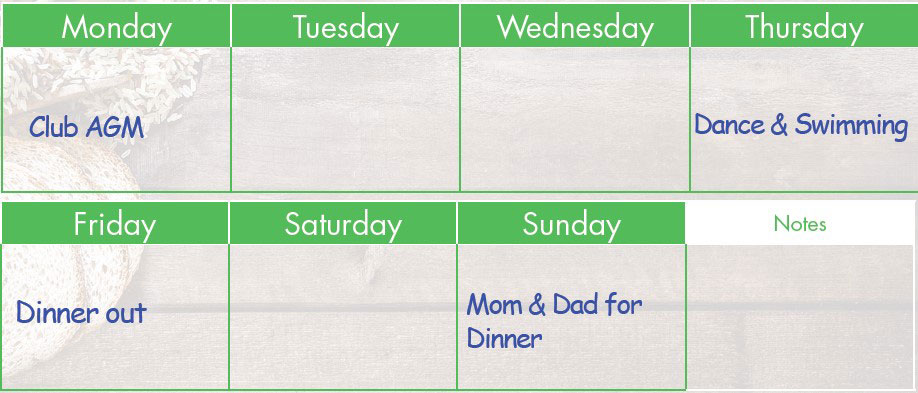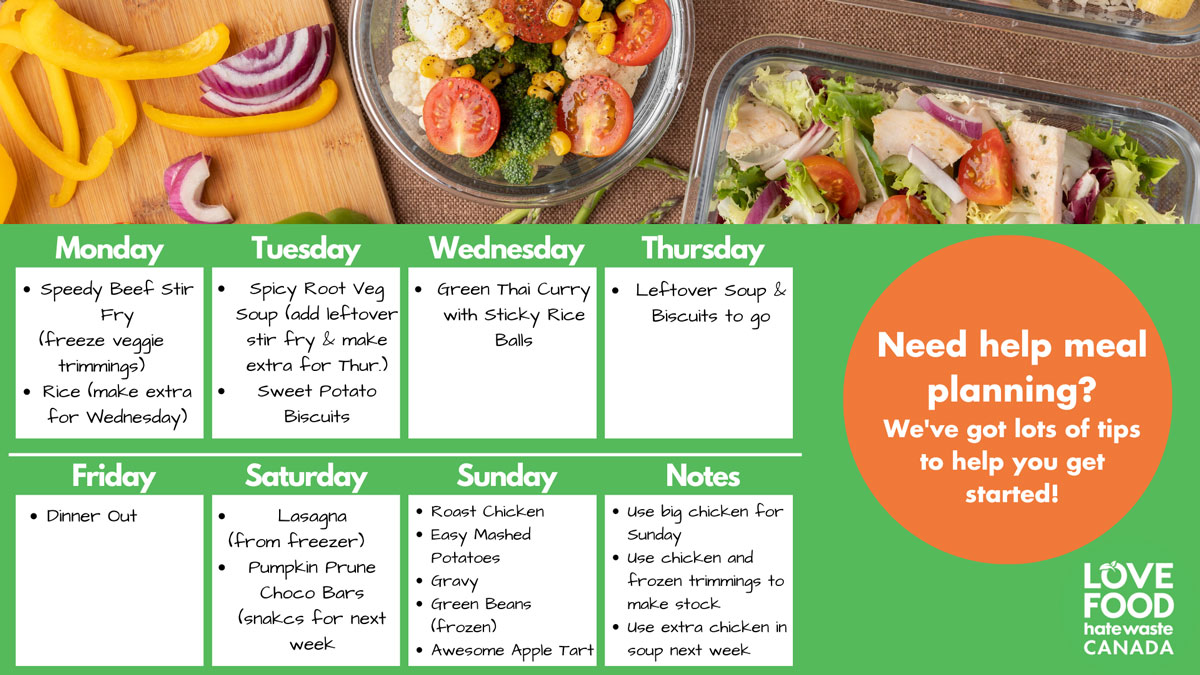Make a Winter Meal Plan
Making a Meal Plan for Winter
We know one of the best ways to prevent food waste is to plan our meals and shop accordingly. Sounds easy enough, but like any good habit, it takes a little practice to feel confident. Keep at it, we know you can do it and will appreciate the time, money, and food you’ll save.
Our Food Waste Champion, Getty Stewart, walks us through how she uses our Love Food Hate Waste Meal Planner and tips for meal planning to create a weekly meal plan for her family this winter.
1. What Does Your Schedule Look Like this Week?
My meal planning always starts with a look at what the week has in store for us. I jot down regularly scheduled events and special occasions. This gives me a good idea of how much time I’ll have for prep and when to plan for quick grab and go meals.

2. What’s Ready to Use – Fridge, Freezer, Pantry
Once I have a feel for what the upcoming week is like, I check what’s in my fridge, freezer, and pantry to see what’s ready to use and what I need to add to my grocery list. Often, just having a good look at what I already have inspires some sort of meal idea. If nothing jumps to mind, I consider classic “clean out the fridge” recipes like frittatas, omelettes, soups or stir fries.
More often than I’d like to admit, I’ve forgotten about frozen meals in the freezer, so I’ve set a goal to use up at least one meal from the freezer every week.
Here’s a typical look at what I might have in the fridge, freezer, and pantry in November.
3. Generate Possible Meal Ideas
Once I’ve taken inventory, I start jotting down meal ideas inspired by what I already have. From there, I usually choose meals that:
- are easy for me to make (I experiment with new recipes on the weekend)
- use seasonal ingredients
- piggyback ingredients so that I can prep them once and use them several times
During this step, my mind wanders all over and things change several times, but that’s part of the creative process! Here’s a look at what goes on in my mind…
That lasagna in the freezer needs to be used up. It’ll take a while to cook so it would be perfect for Saturday. Ooh, that’ll give me time to bake chocolate snack bars for next week using the frozen pumpkin puree from Halloween.The broccoli, carrots and peppers would be perfect for a stir fry. Did I see a packet of stir fry sauce in the cupboard? Of course, stir fry would be great with rice. Oh, I should make extra rice so I can make stir-fried rice or Sticky Rice Balls with Green Thai Curry on another night. But not too much extra, remember last time! Check the Portion Size Guide.
What about the cooked sweet potatoes? How about that biscuit recipe I saw? They would go great with soup which would use up my extra veggies, including the butternut squash and veggies in the freezer. I should double the recipe so we can use the soup on our crazy Thursday night. Mel could take it to dance in a container. It’ll keep for four days, so if I make something else in between, nobody will care that they get the same soup twice in one week!
Mom and dad are coming for Sunday dinner, don’t forget the apple tart.
Once I’ve had this very important conversation with myself, I plot meal ideas and specific recipes on my meal planner. Of course, there will likely be changes during the week, but having a plan sure feels good!

4. Make a Shopping List
Once my meal plan is finished, I make a shopping list.
First, I double check what I have on hand. If I have any doubt about how much I’ll need, I check the portion size guide to avoid overbuying and over cooking.
While making my shopping list I go to the recipe, look at how much of each ingredient is needed to make the recipe (Speedy Beef Stir Fry) to serve my family of 4 and calculate how much extra ingredients I will have. For example, the package from the store is bigger than the eight-ounce beef steak I need for this recipe. I will have extra beef which I will now be able to add into a second recipe for the next night. The same thing will happen for the bunch of spring onions I purchase. I will repeat the same process with all the recipes I plan for the week.
To finish off our shopping list I add our favourite snack, breakfast, and lunch foods and any staples we need. Finally, I’m ready for the grocery store. When I come home, I use the A to Z food storage guide if I’m not sure how to store my new groceries.
That’s how I put together a meal plan. It does take a little thinking time, but I never regret doing it! It eliminates the stress of “What to Make for Dinner” and helps me prevent food waste and save money.
So What’s in Your Fridge?
Now you tell us – what’s in your fridge and how are you planning to use it in upcoming meals? We love hearing about how people repurpose their leftovers and use up what’s in their fridge and pantry. Share your photos and ideas with us on Instagram at @lovefoodhatewasteca.
For easy reference, you can find the recipes in Getty’s one-week winter meal plan right here:
Speedy Beef Stir Fry
Spicy Root Vegetable Soup
Sweet Potato Biscuits
Green Thai Curry with Sticky Rice Balls
Pumpkin Prune Chocolate Bars
Easy Mashed Potatoes
Awesome Apple Tart


